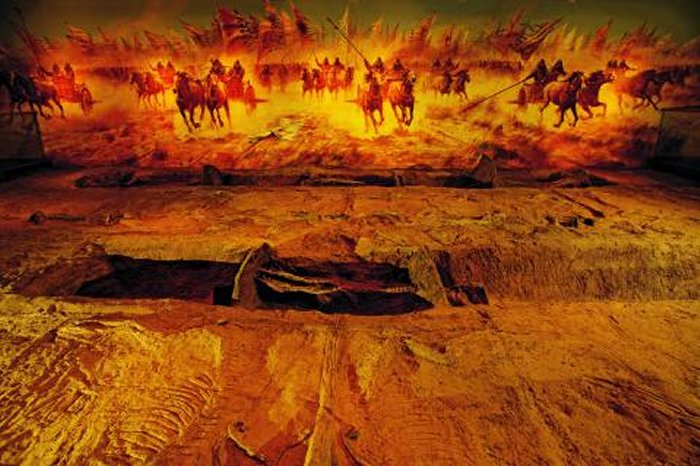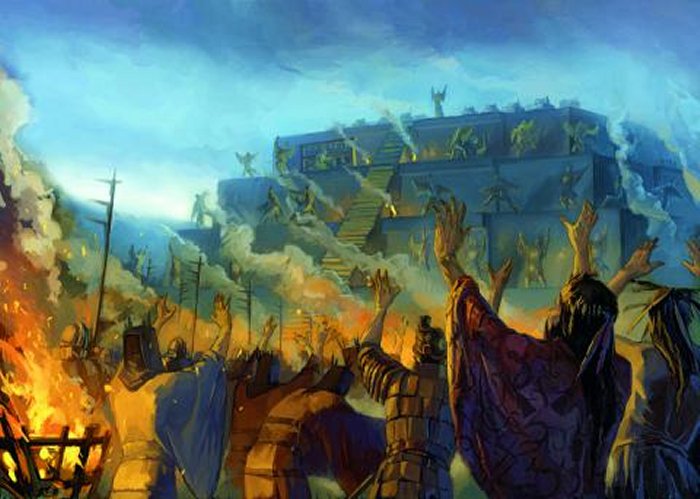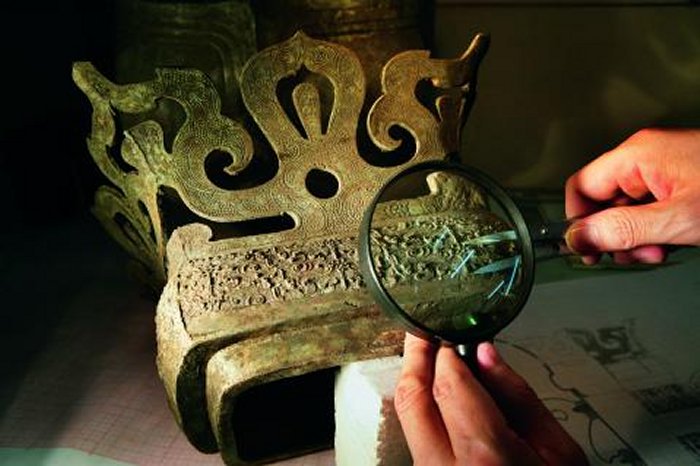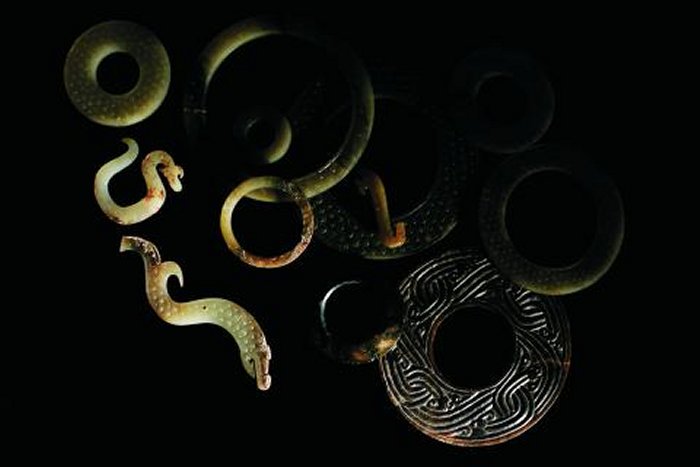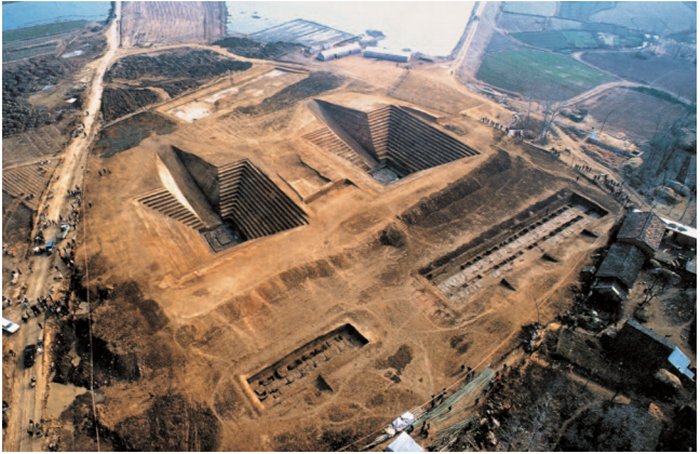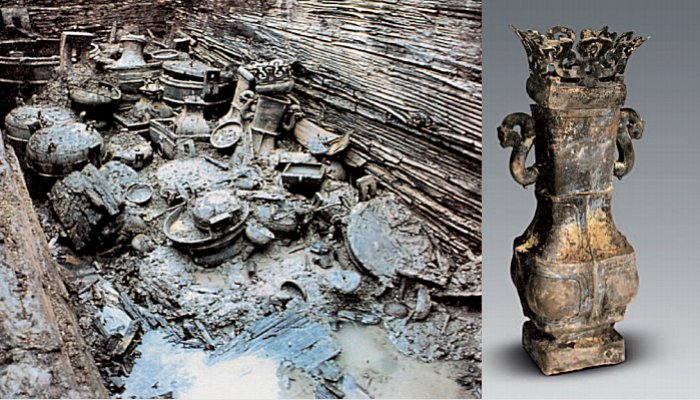Mysterious Lost Civilization Of Chu And Its Powerful Kingdom
Ellen Lloyd - AncientPages.com - The ancient kingdom of Chu flourished in China between around 1030 – 223 B.C. According to legends, the royal family of Chu descended from the Yellow Emperor.
Who Were The Chu People?
The beginning of Chu’s history remains disputed as few historical facts are available. What is known is that according to an ancient legend, the earliest ancestor in the lineage of the Chu royal family is Zhu Rong, the God of Fire. Zhu Rong acted as Emperor Shun’s huozheng (“Minister of Fire”).
His main duties involved observation of the sky and seasons, all everything related to fire (such as burning grass in wastelands and fire hazard prevention), as well as ceremonies to pay respect to the heavens.
This is a restored painting of Chu’s conquests unearthed in the Jiuliandun Chu Tomb in Hubei. It was during the invincible conquests that the Chu had disseminated its own distinctive culture, and at the same time, it absorbed and digested the local cultures of where it had expanded to, eventually forming the unique and inclusive Chu culture. Photo/He Wei
Around the end of the Shang Dynasty, a branch of Zhu Rong’s lineage relocated southward from the central plains to the banks of the Danjiang River in southwestern Henan Province. Xiong Yi, who was a descendant of the Yellow Emperor and Zhuanxu through his great-grandfather Yuxiong established the first capital of Chu at Danyang (present-day Xichuan in Henan). Later, as the Kingdom of Chu expanded, their people mostly moved to the east and south, into other territories occupied by the Southern Barbarian people.
Xiong Yi’s appointment as a vassal to the Zhou court also marked the beginning of the Kingdom of Chu’s 800-year history.
Chu People Believed In Ghosts And Witchcraft
The Chu people had their own special view of the world and the universe. For one thing, they believed in magic, ghosts, and witchcraft.
The people of Chu considered death to be a passage into another form of life, and thus had a custom of elaborate burials, for which members of high-ranking nobility would be buried along with large quantities of bronze and jade artifacts, instruments, and bamboo scrolls. Each tomb resembled a small-scale museum by modern standards.
At the beginning of their history, the Chu civilization worshipped not only their ancestors but also totems of the Sun, fire and the legendary bird Phoenix. Later, when the Chu civilization grew larger and entered new territories, they adopted many other beliefs and eventually they became a multi-gods religious society. However, they continued to worship especially their ancestors and the giant mountains.
The Chu Civilization Was Defeated By King of Qin, Ying Zheng
The Chu kingdom became especially significant during the late Shang Dynasty (c. 1600 – c. 1046 BC) and throughout the Spring-Autumn and Warring States periods (770 – 221 BC).
The Chu kingdom included most of the present-day provinces of Hubei and Hunan, along with parts of Chongqing, Guizhou, Henan, Anhui, Jiangxi, Jiangsu, Zhejiang, and Shanghai. For more than 400 years, the Chu capital Danyang was located at the junction of the Dan and Xi Rivers near present-day Xichuan County, Henan, but later moved to Ying.
Unfortunately, the magnificence of Chu culture did not last for long. In 223 BC, the King of Qin, Ying Zheng, began his conquest to unify all of China, beginning with a 600,000-soldier siege on Chu. The battle with Qin, the first imperial dynasty of ancient China was more than the Chu civilization could handle. The Chu kingdom collapsed and its civilization and rich culture vanished.
Archaeological Discoveries Shed Light On Lost Chu Civilization
That would be the end of the story if it hadn’t been for the mysterious “underground Kingdom of Chu”, where we can admire marvelous collections of bronze artifacts, silks and embroideries, paintings, and music.
For the first time ever, long-lost Chu artifacts can now see the light of day once again, and expand our knowledge of the Chu people and their culture. According to historical and archaeological records, there were more than a dozen of varieties of silk products in Chu.
These fabrics are proved to be extremely sophisticated with their complex structure, bright colors, complete lineage, advanced lineage and exquisitely detailed patterns.
By examining several ancient Chu tombs archaeologists have gained a deeper insight into the lives and beliefs of this interesting civilization. Based on the findings discovered so far, scientists think that the large tombs probably belonged to people of high status of the mid- to late-Warring States period (5th to 3rd century BCE). In one large tomb, archaeologists came across several bells, but they were not in tune and couldn't have been used as musical instruments, though it should be added that there were ancient musical instruments among the discovered artifacts.
Researchers also found that there is a close connection between the physical placing of the
burial objects and their internal significance in relation to one another. Knowledge about the Chu peoples' rituals, customs, and traditions is still incomplete.
Although it is still a matter of debate, many historians think Ji’nancheng was the capital of the Chu kingdom. Excavations in the Ji’nancheng Ruins also revealed a tomb of particular interest that could contain the bodies of Chu kings.
This once powerful kingdom was never really erased from history. Today, many historians believe that a large part of Han culture is in fact descended from Chu culture.
Written by - Ellen Lloyd – AncientPages.com
Copyright © AncientPages.com All rights reserved. This material may not be published, broadcast, rewritten or redistributed in whole or part without the express written permission of AncientPages.com
Expand for referencesReferences:
Patricia Buckley Ebrey, Chinese Civilization
More From Ancient Pages
-
 Unique Glass Bead From The Time Of Jesus Discovered In Fire Pit In Sweden
Archaeology | Jun 17, 2017
Unique Glass Bead From The Time Of Jesus Discovered In Fire Pit In Sweden
Archaeology | Jun 17, 2017 -
 Pre-Columbian People Of The Amazon Altered Their Landscape Thousands Of Years Earlier Than Previously Thought
Archaeology | Jun 14, 2021
Pre-Columbian People Of The Amazon Altered Their Landscape Thousands Of Years Earlier Than Previously Thought
Archaeology | Jun 14, 2021 -
 Treasure Trove Of Spices Found On The Sunken Medieval Ship Gribshunden
Archaeology | Feb 11, 2023
Treasure Trove Of Spices Found On The Sunken Medieval Ship Gribshunden
Archaeology | Feb 11, 2023 -
 Puzzling Case Of An Ancient French Giant Whose Bones Caused Sensation And Controversy
Featured Stories | Jan 22, 2019
Puzzling Case Of An Ancient French Giant Whose Bones Caused Sensation And Controversy
Featured Stories | Jan 22, 2019 -
 Evidence The Khufu Channel Aided The Construction Of The Giza Pyramids Found – Scientists Say
Archaeology | Aug 31, 2022
Evidence The Khufu Channel Aided The Construction Of The Giza Pyramids Found – Scientists Say
Archaeology | Aug 31, 2022 -
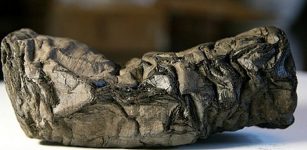 2,000-Year-Old Herculaneum Scrolls Will Be Unwrapped And Deciphered
Archaeology | Oct 8, 2019
2,000-Year-Old Herculaneum Scrolls Will Be Unwrapped And Deciphered
Archaeology | Oct 8, 2019 -
 Mysterious Hockomock Swamp – A Vortex To The Unknown In Massachusetts?
Featured Stories | Oct 9, 2019
Mysterious Hockomock Swamp – A Vortex To The Unknown In Massachusetts?
Featured Stories | Oct 9, 2019 -
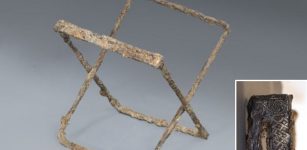 Extremely Rare Medieval Folding Chair Reveals Its Secrets
Archaeology | Oct 13, 2023
Extremely Rare Medieval Folding Chair Reveals Its Secrets
Archaeology | Oct 13, 2023 -
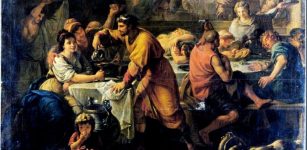 Saturnalia Feasts In Roman Empire
Ancient History Facts | Jun 30, 2018
Saturnalia Feasts In Roman Empire
Ancient History Facts | Jun 30, 2018 -
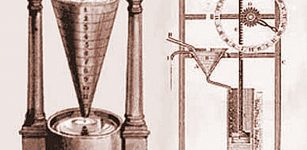 Ancient Greeks Invented Alarm Clocks
Ancient History Facts | May 6, 2016
Ancient Greeks Invented Alarm Clocks
Ancient History Facts | May 6, 2016 -
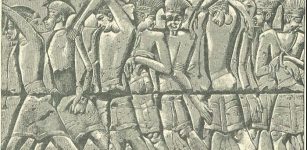 Mysterious Philistines: They Migrated Across Mediterranean – DNA Testing Shows
Archaeology | Jul 4, 2019
Mysterious Philistines: They Migrated Across Mediterranean – DNA Testing Shows
Archaeology | Jul 4, 2019 -
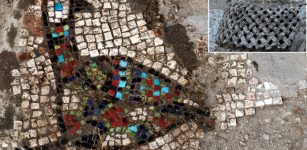 St. Simeon’s Monastery And History Of Its Founder Shed Light On Christian Past In Anatolia
Archaeology | Nov 28, 2020
St. Simeon’s Monastery And History Of Its Founder Shed Light On Christian Past In Anatolia
Archaeology | Nov 28, 2020 -
 2,000 Years Ago Mysterious Foreigner With Unique Ancestry Traveled To Cambridgeshire – Who Was He?
Archaeology | Dec 27, 2023
2,000 Years Ago Mysterious Foreigner With Unique Ancestry Traveled To Cambridgeshire – Who Was He?
Archaeology | Dec 27, 2023 -
 Mysterious Medieval Cemetery In Wales With People Buried In Unusual Positions Puzzles Archaeologists
Archaeology | Jan 3, 2024
Mysterious Medieval Cemetery In Wales With People Buried In Unusual Positions Puzzles Archaeologists
Archaeology | Jan 3, 2024 -
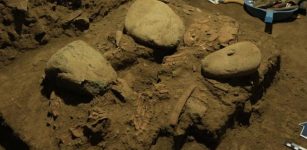 Mysterious Toaleans – Remains Of Unknown Humans Who Lived 8,000 Years Ago Discovered In The Leang Panninge Cave
Archaeology | Aug 26, 2021
Mysterious Toaleans – Remains Of Unknown Humans Who Lived 8,000 Years Ago Discovered In The Leang Panninge Cave
Archaeology | Aug 26, 2021 -
 Controversial Hollow Earth Theory – Startling Discoveries And Different Conclusions – Part 2
Featured Stories | Jun 25, 2019
Controversial Hollow Earth Theory – Startling Discoveries And Different Conclusions – Part 2
Featured Stories | Jun 25, 2019 -
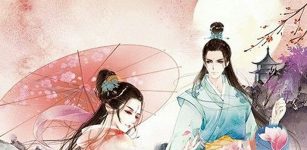 Izanagi And Izanami In Shinto Beliefs And How They Created The World
Featured Stories | Mar 28, 2019
Izanagi And Izanami In Shinto Beliefs And How They Created The World
Featured Stories | Mar 28, 2019 -
 Mystery Of The Horrible ‘Thing’ Found In A Dominican Monastery
Featured Stories | Sep 4, 2023
Mystery Of The Horrible ‘Thing’ Found In A Dominican Monastery
Featured Stories | Sep 4, 2023 -
 Unique Maya Center Of Copán With History Recorded In 2500 Hieroglyphics
Civilizations | Nov 7, 2018
Unique Maya Center Of Copán With History Recorded In 2500 Hieroglyphics
Civilizations | Nov 7, 2018 -
 Ancient Burial Chambers Decorated With Mythological Figures Of Hercules, Medusa, Eros – Unearthed In Bursa, Turkey
Archaeology | Feb 21, 2017
Ancient Burial Chambers Decorated With Mythological Figures Of Hercules, Medusa, Eros – Unearthed In Bursa, Turkey
Archaeology | Feb 21, 2017

